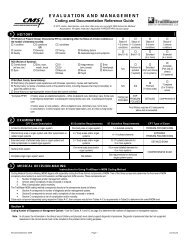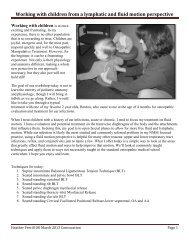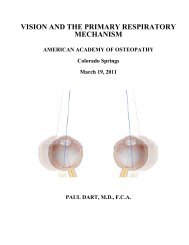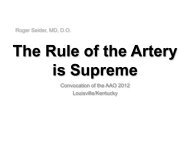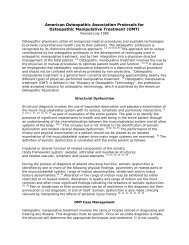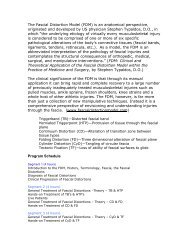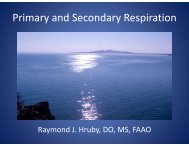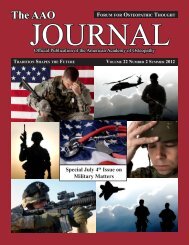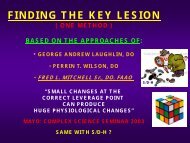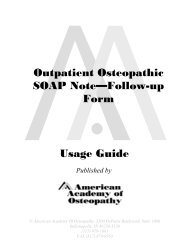Stiles - American Academy of Osteopathy
Stiles - American Academy of Osteopathy
Stiles - American Academy of Osteopathy
You also want an ePaper? Increase the reach of your titles
YUMPU automatically turns print PDFs into web optimized ePapers that Google loves.
Richard L. Van Buskirk, DO, PhD, FAAO
� The grounding principles derived from Dr.<br />
Still’s methods are:<br />
� Start with a restricted tissue at its position <strong>of</strong> ease;<br />
� Introduce a force vector from another but connected<br />
body part focused on the restricted tissue;<br />
� Use the force vector as a mechanical connector to<br />
carry the tissue from its ease through the restriction.
� The redeveloped Still<br />
Technique is focused on the<br />
treatment <strong>of</strong> each tissue<br />
restriction.<br />
� It uses the methodology Dr.<br />
Still developed and used from<br />
the time <strong>of</strong> the founding <strong>of</strong><br />
osteopathy.<br />
� It is gentle, fast and effective.
� Used to treat the whole body Still Technique<br />
can require as many as 60 individual<br />
treatments. Needless to say, this is not very<br />
efficient.<br />
� Treating each individual somatic dysfunction<br />
as it is found, but treating throughout the body<br />
is successful in producing a decrease in<br />
musculoskeletal load and concomitant decrease<br />
in pain.<br />
� This has been the strategy for most <strong>of</strong> my years<br />
<strong>of</strong> practice.
� By the end <strong>of</strong> his life Dr. Andrew<br />
Taylor Still appears to have been<br />
using a new variation <strong>of</strong> his method<br />
that provides a single whole-body<br />
treatment.<br />
� Dr. Ed <strong>Stiles</strong> reintroduced this Still-<br />
Laughlin method. He learned it from<br />
Dr. George A. Laughlin, A.T. Still’s<br />
grandson. According to Dr. <strong>Stiles</strong>, Dr.<br />
Laughlin used HVLA and s<strong>of</strong>t tissue<br />
techniques exclusively until he came<br />
back from Dr. W.G. Sutherland’s first<br />
Cranial course. After that he only<br />
used this new method <strong>of</strong> treatment.
� Although there is no formal evidence Dr.<br />
Sutherland was in a course taught by Dr. Still,<br />
he was a student at the ASO at the beginning <strong>of</strong><br />
the twentieth century when the old doctor was<br />
still very active on campus. Dr. Still<br />
presumably developed this newer version <strong>of</strong><br />
his method during that period.<br />
� Dr. Sutherland discussed using Dr. Still’s<br />
methodology throughout his writings.
“The principle used and taught by Dr.<br />
Still, namely exaggeration <strong>of</strong> the<br />
lesion to the degree <strong>of</strong> release and<br />
then allowing the ligaments to<br />
draw the articulations back into<br />
normal relation.”<br />
W.G. Sutherland, Contributions <strong>of</strong> Thought, p<br />
133<br />
“In all spinal technique it is my<br />
custom to have the patient exercise<br />
his own natural forces rather than<br />
the application <strong>of</strong> mine. There are<br />
no thrusts, no jerks ….”<br />
W.G. Sutherland, Contributions <strong>of</strong> Thought, p 133
� The Still-Laughlin Technique uses the same<br />
methodology as Still Technique, employing the<br />
force vector to move tissue from ease through<br />
restriction.<br />
� It focuses on treating only dysfunctions that<br />
have been variously called “key lesions,”<br />
“areas <strong>of</strong> greatest restriction,” or “primary<br />
dysfunctions”<br />
� I am going to use the term Key Dysfunction for<br />
reasons that will become apparent.
� Over the years the idea <strong>of</strong> a “key lesion” has<br />
reappeared many times in the osteopathic<br />
literature.<br />
� Essentially these are tissue restrictions that go<br />
beyond simple asymmetry <strong>of</strong> presentation and<br />
motion tissue texture changes and tenderness.<br />
� The idea is that when treated these significant<br />
dysfunctions will resolve much more than the<br />
specific tissue treated.
� Details <strong>of</strong> how to identify a Key Lesion tend to<br />
be somewhat vague.<br />
� One <strong>of</strong> the most common has the physician<br />
scan down the spine in the paravertebral<br />
gutters until one sensing finger is “drawn” to<br />
one somatic dysfunction more than others. This<br />
is obviously quite subjective, but does seem to<br />
work in the hands <strong>of</strong> experienced physicians.
� Speece and Crow identify four more methods for<br />
identifying the Key Lesion which may have origin in<br />
Sutherland’s work. These include:<br />
� Systematically working one’s way through the myriad <strong>of</strong><br />
somatic dysfunctions until one releases whatever remains.<br />
Obviously this would not work in the case <strong>of</strong> the Still-Laughlin<br />
Technique.<br />
� Observing the patient walking and visually identifying<br />
immobile axes around which the rest <strong>of</strong> the body moves.<br />
� Introducing traction through the leg <strong>of</strong> a supine patient and<br />
palpably identifying the anchoring point(s) in the fascia.<br />
� Observing the patient changing position, such as getting on or<br />
<strong>of</strong>f <strong>of</strong> a table. Areas <strong>of</strong> obvious restriction, such as a tight psoas,<br />
would show themselves in an abnormal transfer.
� Dr. Ed <strong>Stiles</strong> has developed an extensive<br />
operational technology to identify key<br />
dysfunctions, which he terms the “Area <strong>of</strong><br />
Greatest Restriction.”<br />
� In its most basic form Dr. <strong>Stiles</strong>’ methods<br />
involve a series <strong>of</strong> screening operations starting<br />
with the spine and paraspinal structures and<br />
eventually extending to the extremities. The<br />
following discussion is derived from Dr. <strong>Stiles</strong>’<br />
presentations at the <strong>American</strong> <strong>Academy</strong> <strong>of</strong><br />
<strong>Osteopathy</strong> Convocation, March 2004.
� <strong>Stiles</strong>’ AGR for CERVICAL:<br />
� Start with the patient standing. The physician is behind. Place a<br />
sensing hand on the patient’s posterior neck. Your other hand is on<br />
the top <strong>of</strong> the patient’s head.<br />
� Capture the mid cervical spine between the thumb and forefinger.<br />
This will be your sensing hand.<br />
� Using the hand on the top <strong>of</strong> the head move the head and neck into<br />
flexion. Now introduce right sidebending and then left<br />
sidebending. Using the sensing hand determine if there is<br />
restriction in either direction. If there is restriction in sidebending<br />
to one side then introduce rotation toward that side.<br />
� Now try to introduce motion from the posterior neck on the side <strong>of</strong><br />
restriction toward the anterior neck on the opposite side with the<br />
sensing hand. Test each segment in turn.<br />
� Some segments will move easily and have a “s<strong>of</strong>t end-feel.” At<br />
least one segment may be unyielding and immobile to this<br />
diagonal challenge. The segment with a hard end-feel will be the<br />
AGR (key dysfunction).
� <strong>Stiles</strong>’ AGR for THORACIC AND UPPER BODY:<br />
� The operating hand is on the patient’s shoulder.<br />
� Fingers <strong>of</strong> the sensing hand are on the thoracic paraspinal tissues.<br />
� Introduce sidebending with the operating hand. Listen for ease and restriction.<br />
Transfer the operating hand to the other shoulder. Again compress to produce<br />
sidebending and listen for ease or restriction.<br />
� Now on the relatively restricted side reintroduce sidebending. Next introduce<br />
flexion and anterior rotation and then extension and posterior rotation.<br />
Determine which position feels more restricted.<br />
� Maintaining the position <strong>of</strong> restriction, press each thoracic segment anteriorly<br />
and diagonally toward the side <strong>of</strong> ease with the sensing hand listening for the<br />
“hard end-feel.” Test each segment in turn. The segment with a “hard end-feel”<br />
will be an AGR (key dysfunction).<br />
� If there is no single segment that possesses this hard end-feel but instead the<br />
whole paraspinal area medial to the scapula has a relative restriction, the AGR<br />
is likely to be in the arm on that side. Screen the arm for dysfunction at its<br />
joints.<br />
� Move the sensing hand laterally over the area <strong>of</strong> the mid-thoracic rib angles on<br />
the side <strong>of</strong> restriction. Again use the operating hand to introduce sidebending.<br />
Is the sense <strong>of</strong> restriction greater than or less than the sense <strong>of</strong> restriction along<br />
the spine? If worse, screen the ribs in the same fashion as the paraspinals.
� <strong>Stiles</strong>’ AGR for LOWER HALF OF THE BODY:<br />
� For the lower half <strong>of</strong> the body start with a standing flexion test. Are the lumbar<br />
paravertebral muscles symmetrical? Does one PSIS ride superior?<br />
� Next perform a seated flexion test. Does the lumbar spine show asymmetry <strong>of</strong><br />
motion and/or muscle volume? Does one PSIS ride superior? Is the PSIS shift<br />
stronger for seated than standing flexion? If so look to the lumbar spine,<br />
innominates, and/or sacrum for the SGR.<br />
� If the lumbar paravertebral muscles demonstrate asymmetry in both standing<br />
and seated flexion use the same test as that performed for the thoracic spine<br />
(sidebending from the shoulder). Is one side <strong>of</strong> the lumbar spine restricted? Can<br />
you localize a segment that has a diagonal hard end-feel when the regional<br />
restriction is maximized?<br />
� Now use the same sidebending to test the sacrum. Is sacrum restricted? Did one<br />
PSIS ride superior in the seated flexion test? Evaluate sacral mechanics.<br />
� If the PSIS rides superiorly on the same side in both standing and seated<br />
flexion, it suggests that the pelvis may be the area <strong>of</strong> greatest restriction.<br />
Likewise compression from the shoulder may lateralize restriction to the pelvis.<br />
Evaluate for the nature <strong>of</strong> the restriction.<br />
� If the standing flexion PSIS shift is stronger than the seated, look to the leg on<br />
that side. An additional clue that it might be the leg: diffuse unilateral<br />
paravertebral muscle tightness.
� Dr. Van Buskirk’s method <strong>of</strong> determining spinal key<br />
dysfunction:<br />
� For spinal segments starting with the cervical spine check each<br />
restricted segment in turn.<br />
� Starting with each segment in neutral, introduce flexion and<br />
extension from above (passive process on the patient’s part, active<br />
on yours) but prevent sidebending or rotation. If the palpable<br />
tissue texture changes do NOT disappear the segment is a key<br />
dysfunction. If they do disappear in either flexion or extension the<br />
segment is NOT a key dysfunction.<br />
� For ribs the same principal applies except you use sidebending.<br />
Again if the tissue texture changes fail to disappear the rib<br />
dysfunction is a key dysfunction.<br />
� Pelvic dysfunctions are rarely key dysfunctions but again if the<br />
signs <strong>of</strong> a dysfunction (ASIS or PSIS displacement) disappear with<br />
induced sidebending the dysfunction is not a key lesion.<br />
� Key dysfunctions are likewise rare in the extremities but seem to<br />
be made visible with axial rotation.
� Regardless <strong>of</strong> the method used to determine a<br />
key dysfunction bear in mind the following:<br />
� Key dysfunctions are dependent on the state <strong>of</strong><br />
the whole body. Change the parameters by<br />
treating any somatic dysfunction and the key<br />
dysfunction may move elsewhere.<br />
� The corollary is that key dysfunctions are<br />
unpredictable and rarely in the same place for<br />
one patient over time, much less across the<br />
population.
� The recommendation is that you do a complete<br />
whole body analysis and documentation for<br />
somatic dysfunction. Even though you will end<br />
up focusing your actual treatment on a limited<br />
subset <strong>of</strong> dysfunctions, documentation will<br />
allow you to substantiate your claim for having<br />
treated 7-10 areas.<br />
� You will need to know the exact presenting<br />
and ease position for each key dysfunction<br />
along with its restriction.
� Treatment involves stacking<br />
each key dysfunction at its<br />
position <strong>of</strong> ease, one on top <strong>of</strong><br />
another, and then using a<br />
force vector unwind each<br />
through its restriction. The<br />
force vector transfers over the<br />
course <strong>of</strong> treatment from one<br />
key dysfunction to the next.<br />
� Typically Still-Laughlin will<br />
successfully treat the whole<br />
body by treating only two or<br />
three key dysfunctions.
� For instance, suppose a patient presents with the following list<br />
<strong>of</strong> somatic dysfunctions:<br />
� OAEr<br />
� C1 Rr<br />
� C3FSrRr<br />
� C4ESlRl<br />
� C5FSrRr<br />
� C7FSrRr<br />
� T1ESrRr<br />
� T3ESrRr<br />
� T4FSlRl<br />
� T5ESrRr<br />
� T7ESrRr<br />
� T8FSlRl<br />
� T11ESrRr<br />
� Rib 1 superior left<br />
� Ribs 3,7 anterior right<br />
� Ribs 4,6 posterior left<br />
� L2FSrRr<br />
� L3ESlRl<br />
� L4FSrRr<br />
� Sacrum unilateral R<br />
� Right upslipped innominate<br />
� Numerous cervical, gluteal, and leg muscles with tension
� Key dysfunctions are found at<br />
� C3FSrRr<br />
� T7ESrRr<br />
� L3ESlRl<br />
� Starting with most inferior key dysfunction: L3, position<br />
it in its ease (ESlRl).<br />
� Stack the thoracic T7 vertebra in its ease (ESrRr).<br />
� Now stack the cervical segment C3 in its position <strong>of</strong> ease<br />
(FSrRr).<br />
� Introduce compression (force vector) from the top <strong>of</strong> the<br />
head toward the cervical Key and unwind it through its<br />
restriction.<br />
� Without stopping, shift the focus <strong>of</strong> the force vector to<br />
the thoracic Key and unwind it until you have passed<br />
through its restriction (FSlRl).<br />
� Finally, shift the focus <strong>of</strong> your force vector to the lumbar<br />
Key and unwind it.<br />
� Recheck the key dysfunctions and any other significant<br />
dysfunctions that might be <strong>of</strong> concern, such as the<br />
upslipped innominate.
� Unwinding may be direct from ease through<br />
restriction (Van Buskirk’s version) or it can<br />
follow the fascia as it unwinds (<strong>Stiles</strong>’ version).<br />
� The first few times I tried this I was invariably<br />
surprised that all <strong>of</strong> the somatic dysfunctions I<br />
had previously diagnosed had resolved.
� The Still-Laughlin Technique treats all somatic<br />
dysfunctions and their concomitant neural and<br />
vascular restrictions in a single rapid but<br />
complex dance.<br />
� Still-Laughlin is very efficient, but still treats<br />
everything the more focused methods like<br />
HVLA, Muscle Energy, Counterstrain, and Still<br />
Technique do.
� Still-Laughlin is not limited as to the type <strong>of</strong><br />
tissue treated although its focus is through the<br />
musculoskeletal system.<br />
� Accepting that most disease processes are due<br />
to body-wide dysfunctions, an integrated<br />
whole body treatment such as Still-Laughlin<br />
should be incredibly efficient in removing or<br />
reducing the musculoskeletal load contributing<br />
to disease and preventing the body from<br />
efficiently healing.
� That being said, the Still-Laughlin Technique<br />
requires great skill, extensive anatomical and<br />
physiological knowledge, extreme accuracy in<br />
diagnosis, and ferocious concentration.
Still-Laughlin Integrative treatment<br />
Richard L Van Buskirk, DO, PhD, FAAO<br />
Lab presented at AAO Convocation, March 2012<br />
1. Method <strong>of</strong> Still Technique<br />
a. Determine exact tissue restriction.<br />
b. Determine nature <strong>of</strong> restriction and position <strong>of</strong> ease<br />
c. Set tissue in ease<br />
d. Introduce compression (force vector) from another site toward the tissue<br />
e. Using the compression as lever carry tissue from ease thru restriction<br />
2. Basic method <strong>of</strong> Still-Laughlin taught today:<br />
a. Diagnose whole body for medical problems and detailed somatic dysfunction<br />
b. Evaluate for the key lesions or areas <strong>of</strong> greatest restriction<br />
c. Evaluate key lesions for exact nature <strong>of</strong> restrictions and exact positions <strong>of</strong> ease<br />
d. Set body into position <strong>of</strong> ease for lowest key lesion<br />
e. Stack each additional key lesion in its position <strong>of</strong> ease on top <strong>of</strong> all lower<br />
one(s)<br />
f. Introduce compression from site above the top key lesion. Focus the<br />
compression on the top key lesion.<br />
g. Use this force vector to carry the top key lesion from its ease through its<br />
restriction<br />
h. Without removing the compressive force shift its focus to the next inferior key<br />
lesion<br />
i. Carry each successive key lesion from its ease through restriction<br />
j. Re-evaluate the whole body for somatic dysfunctions. Typically all will have<br />
been successfully treated.<br />
3. Diagnose whole body for medical problems and detailed somatic dysfunction<br />
a. Evaluate all primary systems for evidence <strong>of</strong> dysfunction<br />
b. Look for each instance <strong>of</strong> somatic dysfunction<br />
i. In the spine define each segmental restriction as so flexion/extension,<br />
sidebending, and rotation<br />
ii. For pelvis and sacrum determine restriction<br />
iii. For arms and legs determine nature <strong>of</strong> restriction and ease<br />
iv. For muscles and tendons determine ease and restriction<br />
v. For each tissue document findings in a detailed fashion.<br />
1. This will demonstrate for medical-legal-insurance purposes all<br />
that you have treated<br />
2. It will also allow you to have a clear picture <strong>of</strong> your success<br />
and failures in treating the somatic dysfunction and its<br />
concomitant medical problems.<br />
4. Evaluate for the key lesions or areas <strong>of</strong> greatest restriction<br />
a. You can use Dr. <strong>Stiles</strong>’ methods <strong>of</strong> determining the AGR’s<br />
b. Alternatively you can use the following:<br />
i. For spinal segments starting with the cervical spine take each restricted<br />
segment in turn
ii. Holding each segment in neutral, introduce flexion and extension from<br />
above (passive process on the patient’s part, active on yours). If the<br />
palpable tissue texture changes do NOT disappear the segment is a key<br />
lesion. If they do disappear in either flexion or extension the segment<br />
is NOT a key lesion.<br />
iii. For ribs the same principal applies except you use sidebending. Again<br />
if the tissue texture changes fail to disappear the rib dysfunction is a<br />
key lesion.<br />
iv. Pelvic dysfunctions are rarely key lesions but again if the signs <strong>of</strong> a<br />
dysfunction (ASIS or PSIS displacement) disappear with induced<br />
sidebending the dysfunction is not a key lesion.<br />
v. Key lesions are likewise rare in the extremities but seem to be made<br />
visible with axial rotation.<br />
5. Evaluate key lesions for exact nature <strong>of</strong> restrictions and exact positions <strong>of</strong> ease<br />
a. This is very important. However you should have already determined these<br />
factors when you first performed you somatic dysfunction list.<br />
6. Set body into position <strong>of</strong> ease for lowest key lesion<br />
7. Stack each additional key lesion in its position <strong>of</strong> ease on top <strong>of</strong> all lower one(s)<br />
8. Introduce compression from site above the top key lesion. Focus the compression on<br />
the top key lesion.<br />
9. Use this force vector to carry the top key lesion from its ease through its restriction<br />
10. Without removing the compressive force shift its focus to the next inferior key lesion<br />
a. Carry each successive key lesion from its ease through restriction<br />
11. Re-evaluate the whole body for somatic dysfunctions. Typically all will have been<br />
successfully treated.<br />
12. Alternatively you can try Dr. <strong>Stiles</strong>’ version and use a force vector my<strong>of</strong>ascial release<br />
focused on the AGR. Both versions produce comparable results.<br />
a. Both treat all somatic dysfunctions and their concomitant neural and vascular<br />
restrictions in a single rapid but complex dance.<br />
b. Still-Laughlin is very efficient, but treats everything the more fractionated<br />
methods like HVLA, Muscle Energy, Counterstrain, and Still Technique do.<br />
c. Still-Laughlin is not limited as to the type <strong>of</strong> tissue treated although its focus<br />
is on the musculoskeletal system.<br />
d. Accepting that most disease processes are due to body-wide dysfunctions, an<br />
integrated whole body treatment such as Still-Laughlin should be incredibly<br />
efficient in removing or reducing the musculoskeletal load contributing to<br />
disease and prevent the body from efficiently healing.




